technical specifications LINCOLN CONTINENTAL 2020 Owners Manual
[x] Cancel search | Manufacturer: LINCOLN, Model Year: 2020, Model line: CONTINENTAL, Model: LINCOLN CONTINENTAL 2020Pages: 609, PDF Size: 6.24 MB
Page 8 of 609
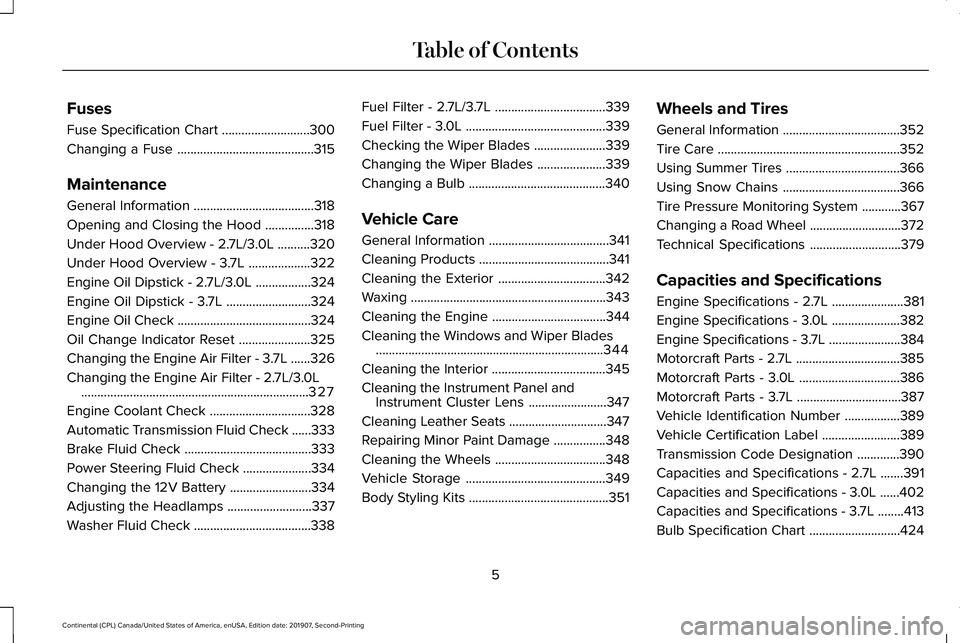
Fuses
Fuse Specification Chart
...........................300
Changing a Fuse ..........................................
315
Maintenance
General Information .....................................
318
Opening and Closing the Hood ...............
318
Under Hood Overview - 2.7L/3.0L ..........
320
Under Hood Overview - 3.7L ...................
322
Engine Oil Dipstick - 2.7L/3.0L .................
324
Engine Oil Dipstick - 3.7L ..........................
324
Engine Oil Check .........................................
324
Oil Change Indicator Reset ......................
325
Changing the Engine Air Filter - 3.7L ......
326
Changing the Engine Air Filter - 2.7L/3.0L ......................................................................
327
Engine Coolant Check ...............................
328
Automatic Transmission Fluid Check ......
333
Brake Fluid Check .......................................
333
Power Steering Fluid Check .....................
334
Changing the 12V Battery .........................
334
Adjusting the Headlamps ..........................
337
Washer Fluid Check ....................................
338Fuel Filter - 2.7L/3.7L
..................................
339
Fuel Filter - 3.0L ...........................................
339
Checking the Wiper Blades ......................
339
Changing the Wiper Blades .....................
339
Changing a Bulb ..........................................
340
Vehicle Care
General Information .....................................
341
Cleaning Products ........................................
341
Cleaning the Exterior .................................
342
Waxing ............................................................
343
Cleaning the Engine ...................................
344
Cleaning the Windows and Wiper Blades ......................................................................
344
Cleaning the Interior ...................................
345
Cleaning the Instrument Panel and Instrument Cluster Lens ........................
347
Cleaning Leather Seats ..............................
347
Repairing Minor Paint Damage ................
348
Cleaning the Wheels ..................................
348
Vehicle Storage ...........................................
349
Body Styling Kits ...........................................
351Wheels and Tires
General Information
....................................
352
Tire Care ........................................................
352
Using Summer Tires ...................................
366
Using Snow Chains ....................................
366
Tire Pressure Monitoring System ............
367
Changing a Road Wheel ............................
372
Technical Specifications ............................
379
Capacities and Specifications
Engine Specifications - 2.7L ......................
381
Engine Specifications - 3.0L .....................
382
Engine Specifications - 3.7L ......................
384
Motorcraft Parts - 2.7L ................................
385
Motorcraft Parts - 3.0L ...............................
386
Motorcraft Parts - 3.7L ................................
387
Vehicle Identification Number .................
389
Vehicle Certification Label ........................
389
Transmission Code Designation .............
390
Capacities and Specifications - 2.7L .......
391
Capacities and Specifications - 3.0L ......
402
Capacities and Specifications - 3.7L ........
413
Bulb Specification Chart ............................
424
5
Continental (CPL) Canada/United States of America, enUSA, Edition date: 201907, Second-Printing Table of Contents
Page 64 of 609
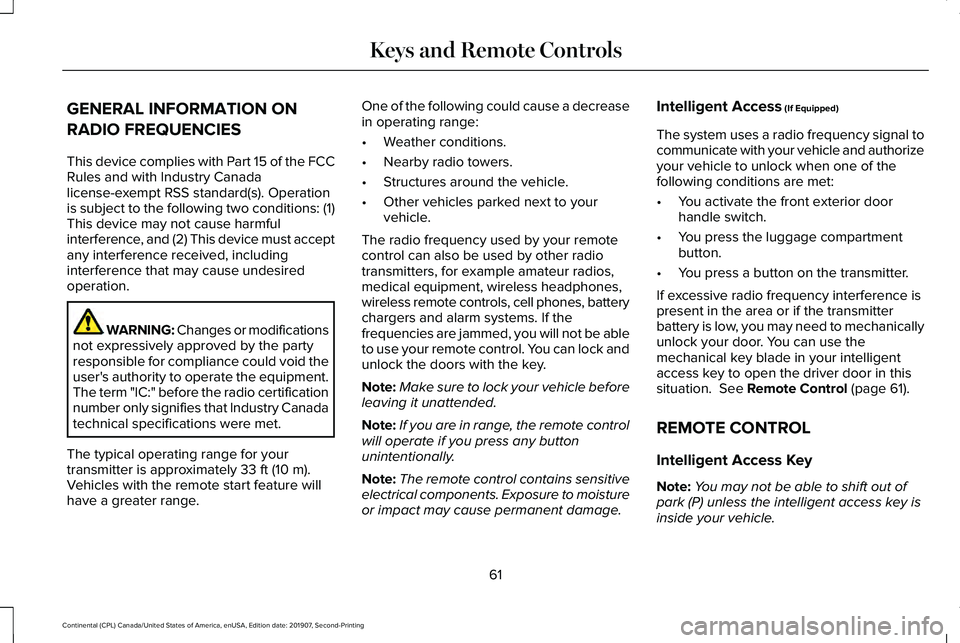
GENERAL INFORMATION ON
RADIO FREQUENCIES
This device complies with Part 15 of the FCC
Rules and with Industry Canada
license-exempt RSS standard(s). Operation
is subject to the following two conditions: (1)
This device may not cause harmful
interference, and (2) This device must accept
any interference received, including
interference that may cause undesired
operation.
WARNING: Changes or modifications
not expressively approved by the party
responsible for compliance could void the
user's authority to operate the equipment.
The term "IC:" before the radio certification
number only signifies that Industry Canada
technical specifications were met.
The typical operating range for your
transmitter is approximately 33 ft (10 m).
Vehicles with the remote start feature will
have a greater range. One of the following could cause a decrease
in operating range:
•
Weather conditions.
• Nearby radio towers.
• Structures around the vehicle.
• Other vehicles parked next to your
vehicle.
The radio frequency used by your remote
control can also be used by other radio
transmitters, for example amateur radios,
medical equipment, wireless headphones,
wireless remote controls, cell phones, battery
chargers and alarm systems. If the
frequencies are jammed, you will not be able
to use your remote control. You can lock and
unlock the doors with the key.
Note: Make sure to lock your vehicle before
leaving it unattended.
Note: If you are in range, the remote control
will operate if you press any button
unintentionally.
Note: The remote control contains sensitive
electrical components. Exposure to moisture
or impact may cause permanent damage. Intelligent Access
(If Equipped)
The system uses a radio frequency signal to
communicate with your vehicle and authorize
your vehicle to unlock when one of the
following conditions are met:
• You activate the front exterior door
handle switch.
• You press the luggage compartment
button.
• You press a button on the transmitter.
If excessive radio frequency interference is
present in the area or if the transmitter
battery is low, you may need to mechanically
unlock your door. You can use the
mechanical key blade in your intelligent
access key to open the driver door in this
situation.
See Remote Control (page 61).
REMOTE CONTROL
Intelligent Access Key
Note: You may not be able to shift out of
park (P) unless the intelligent access key is
inside your vehicle.
61
Continental (CPL) Canada/United States of America, enUSA, Edition date: 201907, Second-Printing Keys and Remote Controls
Page 178 of 609
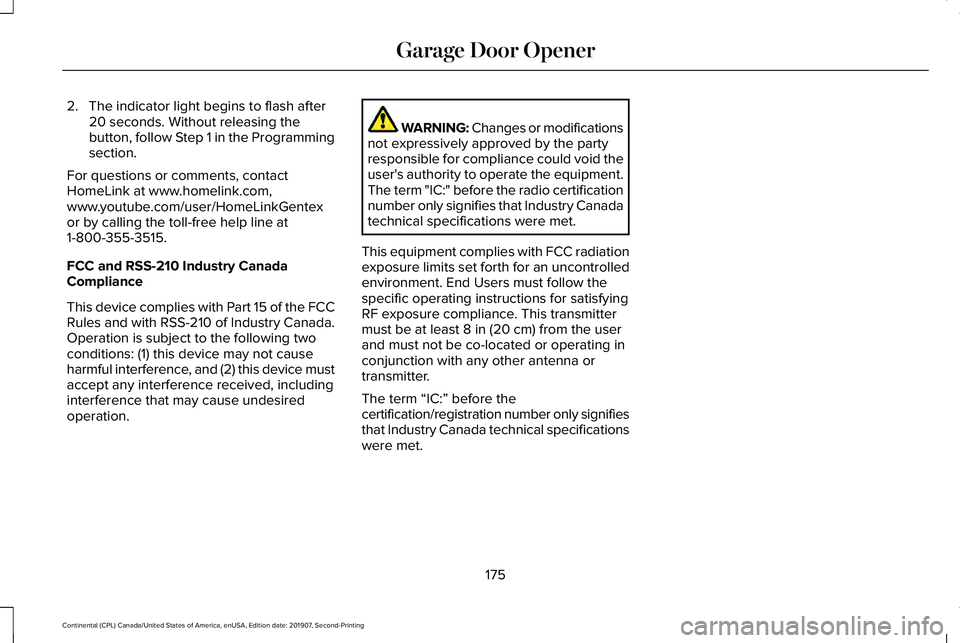
2. The indicator light begins to flash after
20 seconds. Without releasing the
button, follow Step 1 in the Programming
section.
For questions or comments, contact
HomeLink at www.homelink.com,
www.youtube.com/user/HomeLinkGentex
or by calling the toll-free help line at
1-800-355-3515.
FCC and RSS-210 Industry Canada
Compliance
This device complies with Part 15 of the FCC
Rules and with RSS-210 of Industry Canada.
Operation is subject to the following two
conditions: (1) this device may not cause
harmful interference, and (2) this device must
accept any interference received, including
interference that may cause undesired
operation. WARNING: Changes or modifications
not expressively approved by the party
responsible for compliance could void the
user's authority to operate the equipment.
The term "IC:" before the radio certification
number only signifies that Industry Canada
technical specifications were met.
This equipment complies with FCC radiation
exposure limits set forth for an uncontrolled
environment. End Users must follow the
specific operating instructions for satisfying
RF exposure compliance. This transmitter
must be at least 8 in (20 cm) from the user
and must not be co-located or operating in
conjunction with any other antenna or
transmitter.
The term “IC:” before the
certification/registration number only signifies
that Industry Canada technical specifications
were met.
175
Continental (CPL) Canada/United States of America, enUSA, Edition date: 201907, Second-Printing Garage Door Opener
Page 355 of 609

GENERAL INFORMATION
The recommended tire inflation pressures
are on the tire information label on the driver
side B-pillar.
Check and set the tire pressure at the
ambient temperature in which you are
intending to drive your vehicle and when the
tires are cold. See Technical Specifications
(page 379).
Note: Check your tire pressures regularly to
optimize fuel economy.
Only use approved wheel and tire sizes.
Using other sizes could damage your vehicle
and could make the National Type Approval
invalid.
Installation of any tires that are not the
original equipment tire size can cause the
speedometer to display incorrect vehicle
speed. TIRE CARE
Important Information About Low-
Profile Tires
If your vehicle is equipped with
245/40R20 tires, they are low-profile
tires. These tires and wheels are
designed to give your vehicle a sport
appearance. With low-profile tires, you
may notice an increase in road noise
and faster tire wear, depending on road
conditions and driving styles. Due to
their design, low-profile tires and wheels
are more prone to road damage from
potholes, rough or unpaved roads, car
wash rails and curb contact than
standard tires and wheels.
Note:
Your vehicle's warranty does not
cover these types of damages. Extra
caution should be taken when operating
on rough roads to avoid impacts that
could cause wheel and tire damage. Information About Uniform Tire Quality
Grading
Tire Quality Grades apply to new
pneumatic passenger car tires. The
Quality grades can be found where
applicable on the tire sidewall between
tread shoulder and maximum section
width. For example:
Treadwear 200
Traction AA Temperature A.
These Tire Quality Grades are
determined by standards that the United
States Department of Transportation has
set.
352
Continental (CPL) Canada/United States of America, enUSA, Edition date: 201907, Second-Printing Wheels and TiresE142542
Page 371 of 609
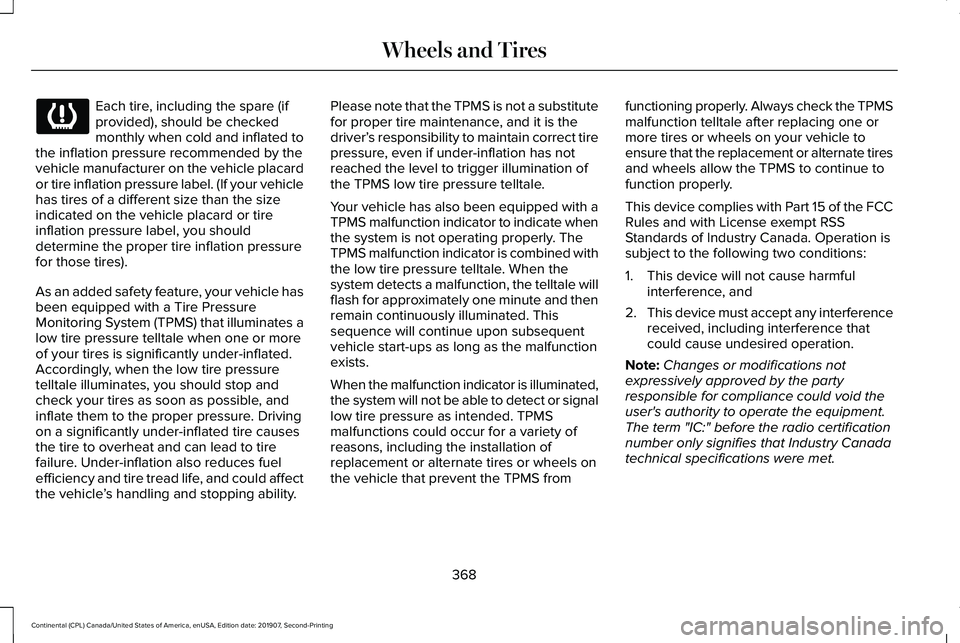
Each tire, including the spare (if
provided), should be checked
monthly when cold and inflated to
the inflation pressure recommended by the
vehicle manufacturer on the vehicle placard
or tire inflation pressure label. (If your vehicle
has tires of a different size than the size
indicated on the vehicle placard or tire
inflation pressure label, you should
determine the proper tire inflation pressure
for those tires).
As an added safety feature, your vehicle has
been equipped with a Tire Pressure
Monitoring System (TPMS) that illuminates a
low tire pressure telltale when one or more
of your tires is significantly under-inflated.
Accordingly, when the low tire pressure
telltale illuminates, you should stop and
check your tires as soon as possible, and
inflate them to the proper pressure. Driving
on a significantly under-inflated tire causes
the tire to overheat and can lead to tire
failure. Under-inflation also reduces fuel
efficiency and tire tread life, and could affect
the vehicle ’s handling and stopping ability. Please note that the TPMS is not a substitute
for proper tire maintenance, and it is the
driver’
s responsibility to maintain correct tire
pressure, even if under-inflation has not
reached the level to trigger illumination of
the TPMS low tire pressure telltale.
Your vehicle has also been equipped with a
TPMS malfunction indicator to indicate when
the system is not operating properly. The
TPMS malfunction indicator is combined with
the low tire pressure telltale. When the
system detects a malfunction, the telltale will
flash for approximately one minute and then
remain continuously illuminated. This
sequence will continue upon subsequent
vehicle start-ups as long as the malfunction
exists.
When the malfunction indicator is illuminated,
the system will not be able to detect or signal
low tire pressure as intended. TPMS
malfunctions could occur for a variety of
reasons, including the installation of
replacement or alternate tires or wheels on
the vehicle that prevent the TPMS from functioning properly. Always check the TPMS
malfunction telltale after replacing one or
more tires or wheels on your vehicle to
ensure that the replacement or alternate tires
and wheels allow the TPMS to continue to
function properly.
This device complies with Part 15 of the FCC
Rules and with License exempt RSS
Standards of Industry Canada. Operation is
subject to the following two conditions:
1. This device will not cause harmful
interference, and
2. This device must accept any interference
received, including interference that
could cause undesired operation.
Note: Changes or modifications not
expressively approved by the party
responsible for compliance could void the
user's authority to operate the equipment.
The term "IC:" before the radio certification
number only signifies that Industry Canada
technical specifications were met.
368
Continental (CPL) Canada/United States of America, enUSA, Edition date: 201907, Second-Printing Wheels and Tires
Page 380 of 609

10. Position the jack so that the vehicle
downward flange rests in the jack
saddle. Use the lug wrench and turn
the jack nut clockwise. When the flat
tire is off the ground, remove the lug
nuts with the lug wrench. 11.
Replace the flat tire with the spare tire,
making sure the valve stem is facing
outward. Reinstall the lug nuts until the
wheel is snug against the hub. Do not
fully tighten the lug nuts until the wheel
has been lowered.
12. Lower the wheel by turning the jack handle counterclockwise. 13. Remove the jack and fully tighten the
lug nuts in the order shown. See
Technical Specifications (page 379). 14.
Fold up the wrench and re-attach to the
jack. Re-position the jack and wrench
assembly into the original vehicle
position and secure with the plastic
wing nut. Securely fasten the jack
before you drive.
15. Unblock the wheel and pick up the warning triangle.
Stowing the flat tire
You cannot store the full-sized road wheel
in the temporary spare tire well.
1. Find the flat tire retainer strap tucked inside the jack channel. Slide the
carpeted load floor into position.
2. Stow the flat tire in the cargo area on the
load floor with the wheel facing up.
Secure the flat tire with the retainer strap
by following the next steps.
377
Continental (CPL) Canada/United States of America, enUSA, Edition date: 201907, Second-Printing Wheels and TiresE201100 12
3
4
5
E75442 E273683
Page 382 of 609
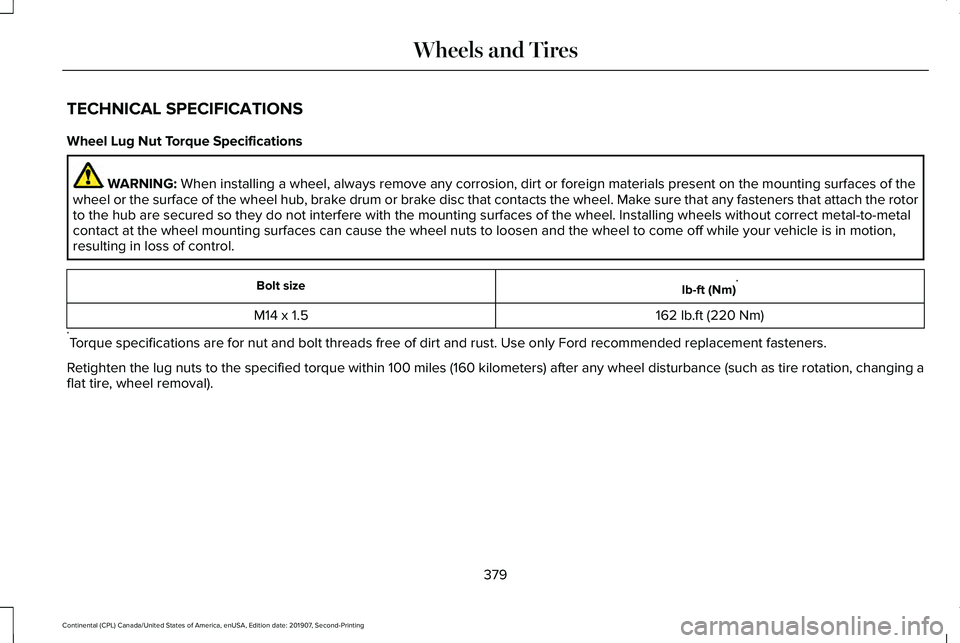
TECHNICAL SPECIFICATIONS
Wheel Lug Nut Torque Specifications
WARNING: When installing a wheel, always remove any corrosion, dirt or foreign ma\
terials present on the mounting surfaces of the
wheel or the surface of the wheel hub, brake drum or brake disc that contacts the wheel. Make sure that any fasteners that attach the rotor
to the hub are secured so they do not interfere with the mounting surfac\
es of the wheel. Installing wheels without correct metal-to-metal
contact at the wheel mounting surfaces can cause the wheel nuts to loose\
n and the wheel to come off while your vehicle is in motion,
resulting in loss of control. Ib-ft (Nm)
*
Bolt size
162 lb.ft (220 Nm)
M14 x 1.5
* Torque specifications are for nut and bolt threads free of dirt and rust.\
Use only Ford recommended replacement fasteners.
Retighten the lug nuts to the specified torque within 100 miles (160 kil\
ometers) after any wheel disturbance (such as tire rotation, changing \
a
flat tire, wheel removal).
379
Continental (CPL) Canada/United States of America, enUSA, Edition date: 201907, Second-Printing Wheels and Tires
Page 578 of 609

Gracenote uses a unique identifier to track
queries for statistical purposes. The purpose
of a randomly assigned numeric identifier is
to allow Gracenote to count queries without
knowing anything about who you are. For
more information, see the web page at
www.gracenote.com for the Gracenote
Privacy Policy.
THE GRACENOTE SOFTWARE, EACH ITEM
OF GRACENOTE DATA AND THE
GRACENOTE CONTENT ARE LICENSED TO
YOU "AS IS". NEITHER GRACENOTE MAKES
ANY REPRESENTATIONS OR WARRANTIES,
EXPRESS OR IMPLIED, REGARDING THE
ACCURACY OF ANY GRACENOTE DATA
FROM THE GRACENOTE SERVERS OR
GRACENOTE CONTENT. GRACENOTE
COLLECTIVELY AND SEPARATELY RESERVE
THE RIGHT TO DELETE DATA AND/OR
CONTENT FROM THE COMPANIES'
RESPECTIVE SERVERS OR, IN THE CASE OF
GRACENOTE, CHANGE DATA CATEGORIES
FOR ANY CAUSE THAT GRACENOTE
DEEMS SUFFICIENT. NO WARRANTY IS
MADE THAT EITHER GRACENOTE
CONTENT OR THE GRACENOTE SOFTWARE
OR GRACENOTE SERVERS ARE
ERROR-FREE OR THAT THE FUNCTIONING
OF THE GRACENOTE SOFTWARE OR
GRACENOTE SERVERS WILL BE
UNINTERRUPTED. GRACENOTE IS NOT
OBLIGATED TO PROVIDE YOU WITH ANY
ENHANCED OR ADDITIONAL DATA TYPES
THAT GRACENOTE MAY CHOOSE TO
PROVIDE IN THE FUTURE AND IS FREE TO
DISCONTINUE ITS ONLINE SERVICES AT
ANY TIME. GRACENOTE DISCLAIM ALL
WARRANTIES EXPRESS OR IMPLIED,
INCLUDING, BUT NOT LIMITED TO, IMPLIED
WARRANTIES OF MERCHANTABILITY,
FITNESS FOR A PARTICULAR PURPOSE,
TITLE, AND NON-INFRINGEMENT. NEITHER
GRACENOTE WARRANTS THE RESULTS
THAT WILL BE OBTAINED BY YOUR USE
OF THE GRACENOTE SOFTWARE OR ANY
GRACENOTE SERVER. IN NO CASE WILL
GRACENOTE BE LIABLE FOR ANY
CONSEQUENTIAL OR INCIDENTAL
DAMAGES OR FOR ANY LOST PROFITS OR
LOST REVENUES FOR ANY REASON
WHATSOEVER. © Gracenote 2007.
Radio Frequency Statement
FCC ID: ACJ-SYNCG3-L
IC: 216B-SYNCG3-L
This device complies with Part 15 of the FCC
Rules and with RSS-210 of Industry Canada.
Operation is subject to the following two
conditions:
(1) This device may not cause harmful
interference, and
(2)
this device must accept any interference
received, including interference that may
cause undesired operation. WARNING: Changes or modifications
not expressively approved by the party
responsible for compliance could void the
user's authority to operate the equipment.
The term "IC:" before the radio certification
number only signifies that Industry Canada
technical specifications were met.
The antenna used for this transmitter must
not be co-located or operating in conjunction
with any other antenna or transmitter.
575
Continental (CPL) Canada/United States of America, enUSA, Edition date: 201907, Second-Printing Appendices
Page 581 of 609

DECLARATION OF CONFORMITY
Radio Frequency Statement
IC Identification Number
FCC Identification Number
SYNC Version
216B-SYNCG3-L
ACJ-SYNCG3-L
3.0
216B-FA170BCARHS
ACJ-FA-170-BCARHS
3.1
216B-FG185SG32MH
ACJ-FG-185-SG32MH
3.2 WARNING: Changes or modifications
not expressively approved by the party
responsible for compliance could void the
user's authority to operate the equipment.
The term "IC:" before the radio certification
number only signifies that Industry Canada
technical specifications were met. These devices comply with Part 15 of the
FCC Rules and with RSS-210 of Industry
Canada. Operation is subject to the following
two conditions:
1. The device does not cause harmful
interference.
2. The device accepts any interference received, including interference that
could cause undesired operation. TYPE APPROVALS
Radio Frequency Certifications for Tire
Pressure Monitoring Sensor(s)
Argentina
578
Continental (CPL) Canada/United States of America, enUSA, Edition date: 201907, Second-Printing AppendicesE207816
Page 607 of 609
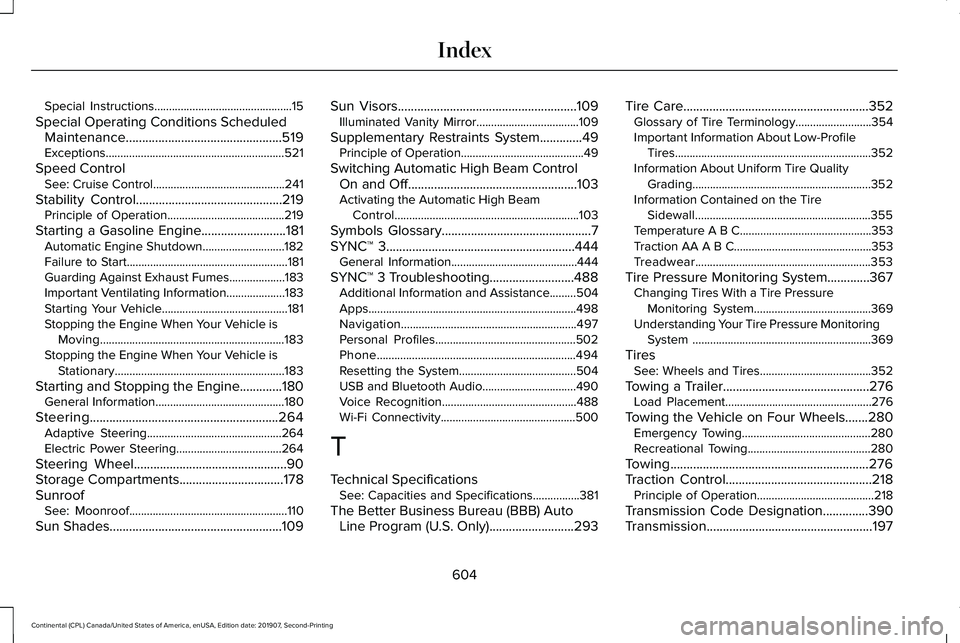
Special Instructions...............................................15
Special Operating Conditions Scheduled Maintenance................................................519
Exceptions.............................................................521
Speed Control See: Cruise Control.............................................241
Stability Control.............................................219
Principle of Operation........................................219
Starting a Gasoline Engine..........................181 Automatic Engine Shutdown............................182
Failure to Start.......................................................181
Guarding Against Exhaust Fumes...................183
Important Ventilating Information ....................183
Starting Your Vehicle...........................................181
Stopping the Engine When Your Vehicle is Moving...............................................................183
Stopping the Engine When Your Vehicle is Stationary..........................................................183
Starting and Stopping the Engine
.............180
General Information............................................180
Steering..........................................................264 Adaptive Steering..............................................264
Electric Power Steering....................................264
Steering Wheel
...............................................90
Storage Compartments................................178
Sunroof See: Moonroof......................................................110
Sun Shades
.....................................................109 Sun Visors.......................................................109
Illuminated Vanity Mirror...................................109
Supplementary Restraints System
.............49
Principle of Operation..........................................49
Switching Automatic High Beam Control On and Off....................................................103
Activating the Automatic High Beam Control
...............................................................103
Symbols Glossary
..............................................7
SYNC™ 3..........................................................444 General Information...........................................444
SYNC™ 3 Troubleshooting..........................488 Additional Information and Assistance.........
504
Apps.......................................................................498
Navigation............................................................497
Personal Profiles................................................502
Phone....................................................................494
Resetting the System........................................504
USB and Bluetooth Audio................................490
Voice Recognition..............................................488
Wi-Fi Connectivity..............................................500
T
Technical Specifications See: Capacities and Specifications................381
The Better Business Bureau (BBB) Auto Line Program (U.S. Only)..........................293 Tire Care.........................................................352
Glossary of Tire Terminology..........................354
Important Information About Low-Profile
Tires...................................................................352
Information About Uniform Tire Quality Grading.............................................................352
Information Contained on the Tire Sidewall............................................................355
Temperature A B C.............................................353
Traction AA A B C...............................................353
Treadwear............................................................353
Tire Pressure Monitoring System.............367
Changing Tires With a Tire Pressure
Monitoring System........................................369
Understanding Your Tire Pressure Monitoring System .............................................................369
Tires See: Wheels and Tires......................................352
Towing a Trailer.............................................276 Load Placement..................................................276
Towing the Vehicle on Four Wheels.......280 Emergency Towing............................................280
Recreational Towing..........................................280
Towing.............................................................276
Traction Control
.............................................218
Principle of Operation........................................218
Transmission Code Designation..............390
Transmission...................................................197
604
Continental (CPL) Canada/United States of America, enUSA, Edition date: 201907, Second-Printing Index